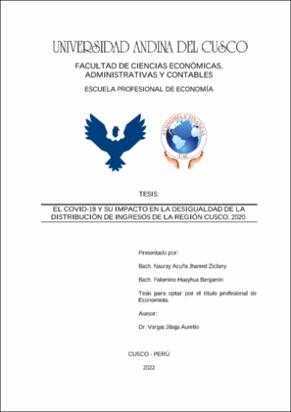| dc.contributor.advisor | Vargas Jibaja, Aurelio | |
| dc.contributor.author | Nauray Acuña, Jhareed Ziclany | |
| dc.contributor.author | Palomino Huayhua, Benjamín | |
| dc.date.accessioned | 2023-01-03T20:18:43Z | |
| dc.date.available | 2023-01-03T20:18:43Z | |
| dc.date.issued | 2022-06-23 | |
| dc.identifier.uri | https://hdl.handle.net/20.500.12557/5125 | |
| dc.description.abstract | La pandemia de COVID-19 representa una de las más grandes amenazas al progreso
conseguido en salud, educación, reducción de la pobreza y distribución de los ingresos en
los últimos 20 años. El efecto de la pandemia es más pronunciado en regiones con niveles
de desigualdad preexistentes, tales como la región del Cusco. En este escenario, la
investigación busca estudiar el efecto que tuvo el COVID-19 en la distribución de ingresos
comparando el año 2019 con el 2020, caracterizar el comportamiento de la tasa de
positividad, incidencia y mortalidad por COVID-19 utilizando un modelo de series de
tiempo y analizar el efecto de las cuarentenas focalizadas sobre el nivel de ingresos en la
región del Cusco. La investigación tiene un alcance descriptivo-correlacional, un diseño no
experimental y un enfoque cuantitativo. Se utiliza información de la Encuesta Nacional de
Hogares para obtener indicadores de ingreso y pobreza, y de la Gerencia Regional de Salud
Cusco para los indicadores de positividad, incidencia y mortalidad. Los resultados
principales han encontrado que el coeficiente de Gini para el período Abril-Diciembre se ha
incrementado en 1 punto porcentual entre el 2019 y el 2020 generando una distribución más
desigual en los ingresos. También se ha identificado que la tasa de positividad, incidencia y
mortalidad han seguido una tendencia a la baja a finales del año 2020, con un proceso
autoregresivo de orden 3 y por un proceso integrado de orden 1. Finalmente, se ha
encontrado que el ingreso anual de los hogares se redujo en hasta un 20% durante los tres
primeros meses de cuarentena obligatoria, según los modelos de regresión lineal. | es_PE |
| dc.description.abstract | The COVID-19 pandemic represents one of the greatest threats to the progress made in
health, education, poverty reduction, and income distribution in the last 20 years. The effect
of the pandemic is more pronounced in regions with pre-existing levels of inequality, such
as the Cusco region. In this scenario, the research seeks to study the effect that COVID-19
had on income distribution by comparing the year 2019 with 2020, characterize the behavior
of the rate of positivity, incidence and mortality from COVID-19 using a series model of
time and analyze the effect of targeted quarantines on the level of income in the Cusco
region. The research has a descriptive-correlational scope, a non-experimental design and a
quantitative approach. Information from the National Household Survey is used to obtain
income and poverty indicators, and from the Cusco Regional Health Management for
positivity, incidence and mortality indicators. The main results have found that the Gini
coefficient for the April-December period has increased by 1 percentage point between 2019
and 2020, generating a more unequal distribution of income. It has also been identified that
the positivity, incidence and mortality rates have followed a downward trend at the end of
the year 2020, with an autoregressive process of order 3 and by an integrated process of
order 1. Finally, it has been found that income Annual household growth fell by up to 20%
during the first three months of mandatory quarantine, according to linear regression models. | en_US |
| dc.format | application/pdf | es_PE |
| dc.language.iso | spa | es_PE |
| dc.publisher | Universidad Andina del Cusco | es_PE |
| dc.rights | info:eu-repo/semantics/openAccess | es_PE |
| dc.rights.uri | https://creativecommons.org/licenses/by-nc-nd/4.0/ | es_PE |
| dc.subject | Distribución de ingresos | es_PE |
| dc.subject | Coeficiente de Gini | es_PE |
| dc.subject | Incidencia | es_PE |
| dc.subject | Mortalidad | es_PE |
| dc.subject | Series de tiempo | es_PE |
| dc.title | El Covid-19 y su impacto en la desigualdad de la distribución de ingresos de la región Cusco, 2020. | es_PE |
| dc.type | info:eu-repo/semantics/bachelorThesis | es_PE |
| thesis.degree.name | Economista | es_PE |
| thesis.degree.grantor | Universidad Andina del Cusco. Facultad de Ciencias Económicas, Administrativas y Contables | es_PE |
| thesis.degree.discipline | Economía | es_PE |
| dc.publisher.country | PE | es_PE |
| dc.subject.ocde | https://purl.org/pe-repo/ocde/ford#5.02.00 | es_PE |
| renati.advisor.dni | 23938021 | |
| renati.advisor.orcid | https://orcid.org/0000-0002-4203-9646 | es_PE |
| renati.author.dni | 70240044 | |
| renati.author.dni | 70410851 | |
| renati.discipline | 311016 | es_PE |
| renati.juror | Carrillo Segovia, María Jesús | |
| renati.juror | Martinez Rojas, Erick Mijail | |
| renati.juror | Paredes Gordón, Tito Livio | |
| renati.juror | Florez Lucana, Ignacio Ramiro | |
| renati.level | https://purl.org/pe-repo/renati/level#tituloProfesional | es_PE |
| renati.type | https://purl.org/pe-repo/renati/type#tesis | es_PE |


